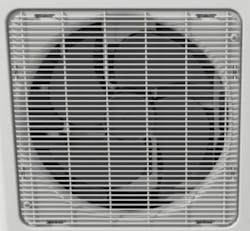
Inverter technology is among the biggest leaps forward for the residential HVAC industry in years. Properly installed inverter systems coupled with variable-speed fans can ramp up and down to match a home’s load, even as it changes throughout the day. These systems can better adapt to shoulder seasons and can be installed with multiple heads on a single condensing unit.
The key words in the paragraph above are “properly installed.” Unfortunately, we are seeing an epidemic of inverter systems that aren’t living up to the promise. In fact, many perform worse than the traditional units they replaced.
An Improperly Installed System
Based on feedback from both contractors and manufacturers, there are an excessive number of inverter systems having callback issues and warranty claims. Most of these issues have little to do with the equipment itself. In most cases, the cause is air distribution.
The most common issue is high static pressure at the return and supply side of the system. Not only do these statics make it virtually impossible to get correct airflow through the air handler, but high statics also cause blower motors to over-amp, drawing many times the power they are designed to operate with. On the condensing side, compressors are constantly cycling as they hopelessly try to match refrigerant flow to the load.
“Once corrections are made, the system should be balanced. When all these things are done right, you will have a happy inverter system and a very happy customer.”
These systems become inefficient in this scenario and prone to early compressor and indoor fan motor failure. In addition, the low airflows create significant comfort issues throughout the home, with some registers getting little to no airflow. Of course, every home is like a fingerprint, so these problems vary from home to home.
The bottom line is these highly touted super-efficient and responsive systems are getting a black eye at an alarming rate. Some other installation issues contribute to this, including improper controls setup, bad thermostat matches, etc., but most problems stem from a mismatched air distribution system.
A Properly Installed System
So, what can be done? For starters, before installing a new inverter system, be sure you take a look at the design. Start by calculating the building load using real-world conditions, not a bunch of assumptions. Then you can determine the correct equipment size. Correct sizing can be done using ACCA Manual S.
After selecting the proper equipment size, you must evaluate the air distribution system to ensure it’s sized for correct static pressures and airflow. In many cases, return and supply plenums and transitions must be redesigned. Other modifications are often needed to make the system work correctly.
Once you make corrections and install the new equipment, you must balance the system to provide the best possible comfort levels throughout the home. When done correctly, you will have a happy inverter system and a very happy customer.
If the original equipment was oversized, and you downsize the new inverter system, there’s a good chance you may not need to make major modifications to the duct system as it may match well with the new equipment. You may still need to change a few transitions and/or seal some of the ductwork. In many cases, downsizing equipment will create a “Goldilocks” effect where the duct system is now just right.
Of course, the process described above requires good training and the right tools to perform the testing to help insure the “whole system” is matched, from the condensing section to the air handler to the air distribution system.
When you think about it, over the past few decades, there has been a considerable focus on matched systems, driven by AHRI (Air Conditioning Heating & Refrigeration Institute) and equipment manufacturers, which is good. As a contractor, there is a third component you need to match to the first two to make an inverter system work properly. That component is the air distribution system. When all three work in unison, the results are truly amazing!
Dominick Guarino is President & CEO of National Comfort Institute (NCI) (nationalcomfortinstitute.com), the nation’s premier High-Performance training, certification, and membership organization. NCI focuses on improving consumer safety, health, and comfort, saving energy, and helping contractors grow and become more profitable. His e-mail is [email protected], or call NCI at 800/633-7058.